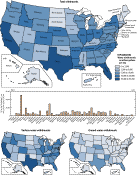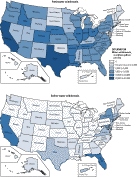
 |
Estimated Use of Water in the United States in 2000
Total Water Use
This section has been revised since its initial release.

Total water use in the United States for 2000 was determined
from estimates of water withdrawals for the eight categories of
public supply, domestic, irrigation, livestock, aquaculture,
industrial, mining, and thermoelectric power (fig. 1). Total
freshwater and saline-water withdrawals for 2000 were estimated to
be 408,000 Mgal/d, or 457,000 thousand acre-feet per year
![]() (table
1). Freshwater withdrawals were 85 percent of the total, and the
remaining 15 percent was saline water. Estimates of withdrawals by
source indicate that for 2000, total surface-water withdrawals were
323,000 Mgal/d, or 79 percent of the total withdrawals for all
categories of use. About 81 percent of surface water withdrawn was
freshwater. Total ground-water withdrawals were 84,500 Mgal/d, of
which 99 percent was freshwater. Nearly all (98 percent)
saline-water withdrawals were from surface water.
(table
1). Freshwater withdrawals were 85 percent of the total, and the
remaining 15 percent was saline water. Estimates of withdrawals by
source indicate that for 2000, total surface-water withdrawals were
323,000 Mgal/d, or 79 percent of the total withdrawals for all
categories of use. About 81 percent of surface water withdrawn was
freshwater. Total ground-water withdrawals were 84,500 Mgal/d, of
which 99 percent was freshwater. Nearly all (98 percent)
saline-water withdrawals were from surface water.
Total withdrawals by category and State are listed in table 2.
![]() For 2000, the largest water withdrawals were for thermoelectric
power and irrigation. Most water (195,000 Mgal/d) was withdrawn for
thermoelectric power, of which 30 percent (59,500 Mgal/d) was
saline. Illinois used the largest amount of freshwater for
thermoelectric power (8 percent of the freshwater withdrawals for
thermoelectric power). The largest saline withdrawals for
thermoelectric power (41 percent) were in California and Florida.
The largest freshwater withdrawals were for irrigation (40 percent
of the total freshwater, or 137,000 Mgal/d). California used the
largest amount of irrigation water and accounted for nearly
one-quarter of the total irrigation withdrawals.
For 2000, the largest water withdrawals were for thermoelectric
power and irrigation. Most water (195,000 Mgal/d) was withdrawn for
thermoelectric power, of which 30 percent (59,500 Mgal/d) was
saline. Illinois used the largest amount of freshwater for
thermoelectric power (8 percent of the freshwater withdrawals for
thermoelectric power). The largest saline withdrawals for
thermoelectric power (41 percent) were in California and Florida.
The largest freshwater withdrawals were for irrigation (40 percent
of the total freshwater, or 137,000 Mgal/d). California used the
largest amount of irrigation water and accounted for nearly
one-quarter of the total irrigation withdrawals.
For 2000, more surface water than ground water was used in all
categories except domestic, livestock, and mining (considering
saline water only) (table 3).
![]() About 52 percent of the fresh
surface-water withdrawals were for thermoelectric power and 30
percent were for irrigation. The largest fresh and saline
surface-water withdrawals were in California. California accounted
for the largest fresh surface-water withdrawals for public-supply,
self-supplied domestic, irrigation, and livestock uses and for the
largest saline surface-water withdrawals for thermoelectric-power
use.
About 52 percent of the fresh
surface-water withdrawals were for thermoelectric power and 30
percent were for irrigation. The largest fresh and saline
surface-water withdrawals were in California. California accounted
for the largest fresh surface-water withdrawals for public-supply,
self-supplied domestic, irrigation, and livestock uses and for the
largest saline surface-water withdrawals for thermoelectric-power
use.
For 2000, most of the fresh ground-water withdrawals, 68
percent, were for irrigation (table 4).
![]() About 52 percent of the
fresh ground-water use nationwide was in California, Texas,
Nebraska, Arkansas, and Florida. About three-fourths of
ground-water withdrawals in California and Texas were for
irrigation; in Nebraska and Arkansas, 94 percent of the
ground-water withdrawals were for irrigation. Ground-water
withdrawals for public supply and irrigation in Florida were nearly
identical. Nationwide, ground-water withdrawals for irrigation were
about 3.5 times larger than the withdrawals for public supply. Only
1 percent of ground-water withdrawals were saline. Nearly all of
the saline ground-water withdrawals were for mining, of which 40
percent were in Texas.
About 52 percent of the
fresh ground-water use nationwide was in California, Texas,
Nebraska, Arkansas, and Florida. About three-fourths of
ground-water withdrawals in California and Texas were for
irrigation; in Nebraska and Arkansas, 94 percent of the
ground-water withdrawals were for irrigation. Ground-water
withdrawals for public supply and irrigation in Florida were nearly
identical. Nationwide, ground-water withdrawals for irrigation were
about 3.5 times larger than the withdrawals for public supply. Only
1 percent of ground-water withdrawals were saline. Nearly all of
the saline ground-water withdrawals were for mining, of which 40
percent were in Texas.
Figure 1 shows that the largest category of water withdrawals
 for 2000 was thermoelectric power (48 percent of total
withdrawals). Irrigation accounted for 34 percent of the total
withdrawals; public supply, 11 percent of the total; self-supplied
industrial, 5 percent of the total; and self-supplied domestic,
livestock, aquaculture, and mining combined accounted for around 2
percent of the total withdrawals.
for 2000 was thermoelectric power (48 percent of total
withdrawals). Irrigation accounted for 34 percent of the total
withdrawals; public supply, 11 percent of the total; self-supplied
industrial, 5 percent of the total; and self-supplied domestic,
livestock, aquaculture, and mining combined accounted for around 2
percent of the total withdrawals.
The geographic distribution of total, total surface-water, and
total ground-water withdrawals is shown in figure 2.
California,
 Texas, and Florida accounted for 25 percent of total withdrawals.
California and Texas accounted for 17 percent of total
surface-water withdrawals, and California accounted for 18 percent
of total ground-water withdrawals. The geographic distribution of
freshwater and saline-water withdrawals by State is shown in figure
3. California and Texas accounted for 18 percent of the total
freshwater withdrawals, and California and Florida accounted for 40
percent of the total saline-water withdrawals.
Texas, and Florida accounted for 25 percent of total withdrawals.
California and Texas accounted for 17 percent of total
surface-water withdrawals, and California accounted for 18 percent
of total ground-water withdrawals. The geographic distribution of
freshwater and saline-water withdrawals by State is shown in figure
3. California and Texas accounted for 18 percent of the total
freshwater withdrawals, and California and Florida accounted for 40
percent of the total saline-water withdrawals.
A comparison of the intensity of freshwater withdrawals by
 State, in gallons per day per square mile, shows that some smaller-
and medium-sized States in the eastern United States have a greater
intensity of freshwater withdrawals per square mile compared to
some larger-sized western States (fig. 4). California and Idaho
also are high in water-use intensity; however, Texas, the State
with the second largest total withdrawals, is relatively low in
water-use intensity.
State, in gallons per day per square mile, shows that some smaller-
and medium-sized States in the eastern United States have a greater
intensity of freshwater withdrawals per square mile compared to
some larger-sized western States (fig. 4). California and Idaho
also are high in water-use intensity; however, Texas, the State
with the second largest total withdrawals, is relatively low in
water-use intensity.
Water Use in the United States | USGS Water Resources of the United States
For more information: wu-info@usgs.gov